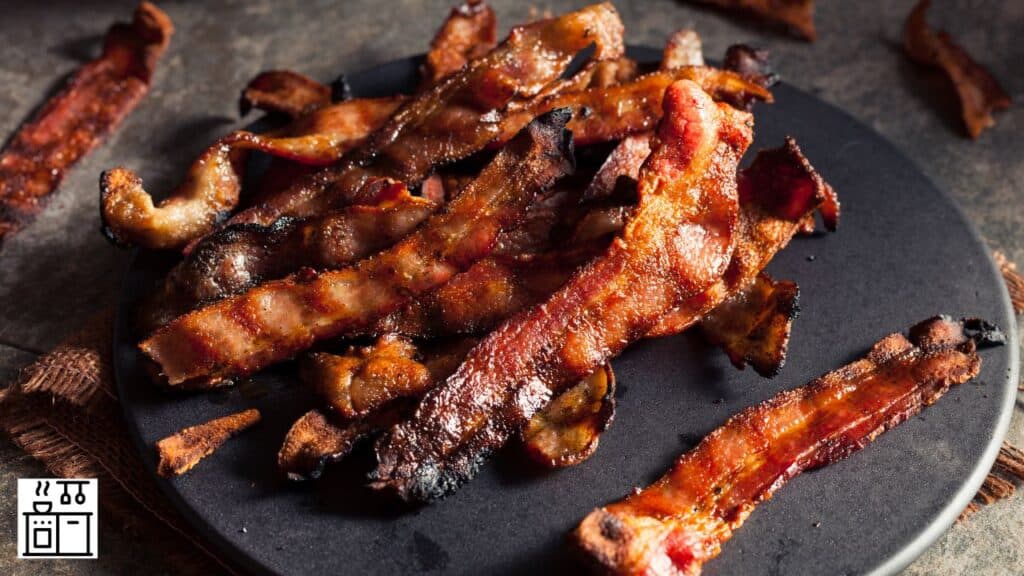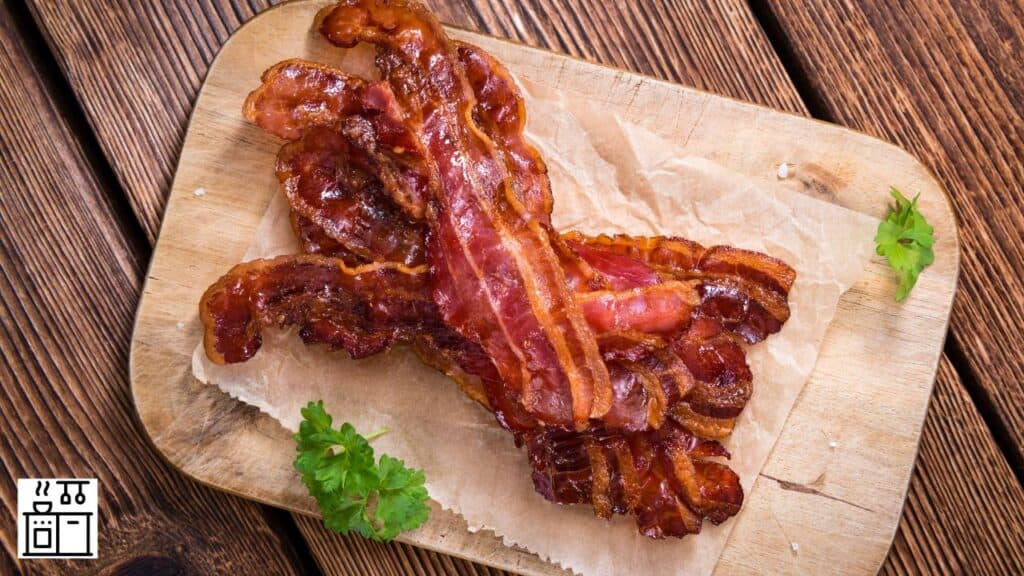One of the best ways to cook bacon is on a griddle.
The larger cooking surface and the presence of grooves make the meat cook better and become crispy.
However, the quality of results depends on the settings like temperature and cooking time.
So, what is the ideal griddle temperature for bacon?
Ideal Griddle Temperature for Bacon
Setting the griddle to the right temperature is important when cooking bacon.
Bacon should be cooked at a temperature of 300°F to 350°F.
It’s up to you to decide if you want to preheat the griddle or not. You can start cold and let the bacon cook in its own fat.
This prevents the meat from sticking to the base.
Alternatively, you can preheat the griddle before placing the bacon for cooking.
Steps to Cook Bacon Perfectly on A Griddle
By paying attention to specific details, you can cook the perfect bacon.
Let’s take a closer look at these factors.
1. Decide Whether to Preheat the Griddle or Not
You can decide whether to preheat your griddle or start it cold, depending on the type of griddle.
Chefs usually recommend preheating cast iron griddles to make the bacon crispy but prevent it from being overcooked.
If you preheat the griddle, it should be at a temperature between 300°F to 350°F.
Sprinkle a few drops of water on the griddle to check if it’s at the right temperature.
If the water sizzles and evaporates immediately, the griddle is hot.
However, if you have an electric griddle, preheating is unnecessary.
You can directly lay the bacon on the cooking surface and wait for it to gradually cook as the heat rises.
The meat will cook gently and not stick to the base.
Recommended Reading: Using Griddle for Grilling | Ideal Griddle Temp for French Toast
2. Leave Enough Space Between the Strips
You can cook bacon from frozen on a griddle. However, it’s not the ideal way to cook it. It will take longer to cook.
We recommend thawing the bacon before cooking.
It will also make it easier to separate the slices and lay them flat on the griddle.
The bacon strips should comfortably fit inside the pan to cook properly.
They shouldn’t hang over the edge or be crowded inside the pan.
If required, you can cut the strips in half to make sure they fit.
Spread the bacon out so each strip doesn’t touch its adjacent strips.
Since bacon releases moisture and cooks in its own fat, you will not need any extra oil.
The strips will reduce in size as they cook.
However, you should still not crowd the pan since overcrowding will prevent the bacon from cooking properly on all sides.
3. Cut the Bacon for Faster Cooking
If you have an electric griddle with a large surface, you can spread the entire bacon flat on it.
Laying it flat helps it crisp up better when compared to laying it on a frying pan.
Since frying pans don’t have as much surface area, the edges of bacon will curl upward and not cook properly.
However, the time taken for cooking will depend on the length and thickness of the meat.
You can cut the bacon strips into smaller sizes to cook faster.
An additional advantage is that it will allow you to avoid any wastage of cooking space.
Another tip is to use a long pair of tongs to conveniently flip the bacon rashers during cooking.
This will prevent it from scratching the adjacent bacon strips during flipping.
If your electric griddle has a non-stick surface, use tongs with silicone edges to avoid scratching the surface.
4. Don’t Increase the Temperature Too Much
The ideal cooking temperature for bacon is between 300°F and 350°F.
It will crisp up at this temperature. You don’t have to increase it any further.
Increasing the griddle temperature beyond 350°F is counter-productive. It will not make the rashes crispier.
However, the bacon may end up with a burnt or over-smoked flavor.
Hastening the cooking process by increasing the temperature can also result in undercooked bits.
Besides, cooking meat at very high temperatures isn’t recommended.
5. Flip the Bacon Regularly

For the bacon to achieve the perfect texture, flip it frequently. Use tongs to turn the bacon every few minutes.
If you avoid doing this, both sides will not cook evenly.
So the side that is facing the pan will cook more than the other side.
By flipping the bacon, you can ensure that both sides are in contact with heat and grease.
This improves the texture of the meat and makes it even.
6. Scrape Away the Fat While Cooking
Bacon is fatty meat. It releases a lot of fat and moisture during cooking.
Hence, you will not need any extra oil to cook bacon. It will cook thoroughly on its own.
However, bacon strips always release a lot of fat. It’s usually more than what is needed for cooking the meat.
The ridges in a cast iron griddle ensure that the oil pools in the depressions.
So the meat will not become greasy.
Nevertheless, if you notice fat accumulating along the sides, scrape it away.
Use a spatula to remove the excess fat and leave just enough for the bacon to continue cooking.
Did you know that you can use this excess fat for various other purposes?
You can scramble eggs or toss vegetables like beans and Brussels sprouts in this fat.
Electric griddles will usually have a hole in the bottom to drain the fat.
The excess fat from the bacon will find its way into the hole and collect there.
You can easily drain it by pulling out the container after the cooking is done.
7. Maintain Steady Griddle Temperature
A griddle will warm gradually. However, the temperature remains stable once it heats up.
This applies to electric and stovetop griddle pans.
Now, the griddle temperature with coal as the fuel may not be steady.
It will vary as the coal burns hotter or cools down.
You must adjust the vents on the top and bottom of the grill to adjust the flow of oxygen and hence the heat.
If the bacon heats up too fast, reduce the heat of the griddle by closing the vents.
Just leave it partially open so the fire doesn’t completely die.
Related Reading: Temperature of Griddle for Burgers | Ideal Griddle Temp for Pancakes
8. Stop Cooking at The Right Time
Depending on the thickness and age of the strips, bacon can take between ten and fifteen minutes to cook.
It will take slightly longer to make the rashes crispier.
However, it’s important to take the bacon off the heat at the right time.
Waiting too long can make it develop a burnt taste.
One way to identify whether the bacon is done is by checking the temperature with a thermometer.
If the temperature is 160°F, it’s done.
Another way is to just look at the meat.
If there are no white lines and the meat is reddish brown and crispy, it’s ready.
After taking the bacon off the griddle, place it on a paper towel.
The towel will absorb the excess oil and prevent the bacon from becoming greasy.

